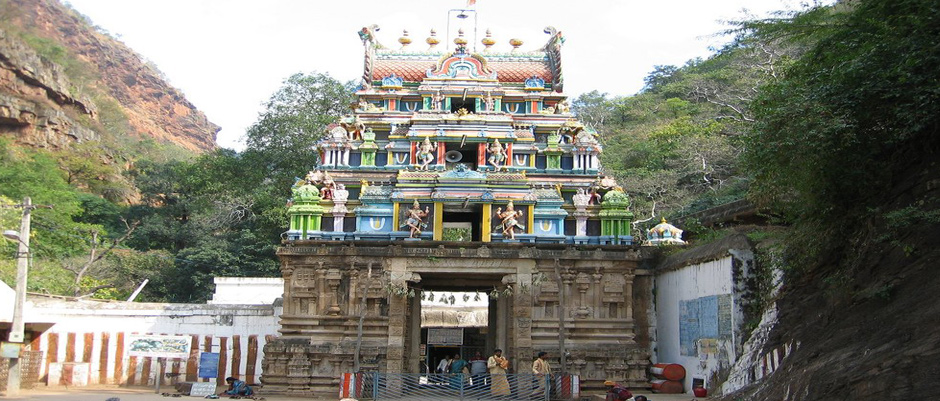
Ahobilam
Ahobilam: A Sacred Journey Through Centuries of Devotion
Nestled in the heart of Andhra Pradesh, Ahobilam stands as one of India's most revered spiritual destinations, carrying within its ancient walls the echoes of centuries of devotion and royal patronage. This sacred site, recognized as the Avatara Sthala of Bhagavan Narasimha, holds the distinction of being both a Kruthayuga Kshetra and one of the 108 Sri Vaishnava Divya Desams.
The Spiritual Foundation
The spiritual significance of Ahobilam was immortalized by Sri Thirumangai Alwar, one of the revered Alwars who lived in the 8th century AD. His ten Pasurams dedicated to Ahobilam continue to inspire devotees today, establishing this sacred site as a cornerstone of Sri Vaishnava tradition.
Central to Ahobilam's religious importance is Sri Ahobila Matha, established by Sri Adivan Satagopa Yatheendra Mahadesikan under the divine command of Sri Ahobila Narasimha Swamy himself. This institution became the nerve center for Sri Vaishnava Ramanuja Sampradayam and played a crucial role in the religious landscape of the Vijayanagara Empire.
Royal Patronage Through the Ages
The Chalukya Legacy
The earliest documented royal patronage dates back to the Chalukya period. According to the Ahobilam Kaifiyat, worship of Ahobila Narasimha Swamy was performed regularly during the reign of Nandana Chakravarthi, who traced his lineage to the legendary kings Parikshit and Janamejaya. This tradition continued under notable Chalukya rulers including Jagadeka Malla, Bhuvaneka Malla, and Tribhuvana Malla Rajas.
An intriguing archaeological discovery—an inscription of Chalukya Kirthivarman II found at Peddapeta—references a person named "Vobula," a colloquial form of "Ahobila," demonstrating the temple's far-reaching influence across the region.
The Kakatiya Connection
The temple's history intertwines with the Kakatiyas through a remarkable tale involving Pratapa Rudra Mahadeva. During a military campaign, when the king camped near Ahobilam at Rudravaram, he attempted to create a gold image of Lord Shiva for his daily worship. Miraculously, the melted gold repeatedly formed into the image of Narasimha Swamy instead. Recognizing this divine intervention, Pratapa Rudra presented the golden Lakshmi Narasimha idol to the first Peethadhipathi, Sri Adivan Satagopa Yatheendra Mahadesikan.
The Reddy Dynasty's Contributions Prolaya Vema Reddy, founder of the Reddy Kingdom of Kondaveedu, claimed the honor of constructing the Sopanamargam (sacred steps) at both Srisailam and Ahobilam. The dynasty's cultural contributions extended beyond architecture—the renowned court poet Yerrapragada, one of the celebrated Kavithrayam trio, authored the magnificent Narasimhapurana, which provides glowing accounts of the deity at Ahobilam.
A significant inscription from King Katama Vema Reddy, dated December 11, 1410 AD, records the grant of an entire village to Ahobila Deva, ensuring the continuation of "Nitya Avasaralu" (daily worship) for the spiritual merit of King Kumaragiri Reddy of Kondaveedu.
The Vijayanagara Golden AgeThe temple reached its zenith under the patronage of the Vijayanagara Empire. King Harihara Maharaya, son of Bukkaraya, constructed a Mukha mantapam in Upper Ahobilam in 1385-86 AD, as recorded in the Mackenzie Manuscript of Ahobilam Kaifiyat.
The most spectacular royal offering came from Sri Krishna Deva Maharaya, who personally visited Ahobilam and presented an extraordinary collection of gifts: a diamond necklace, a ruby and emerald pendant, ruby-encrusted bangles, a golden plate, and the symbolic Thousand Varahas. He also granted the village of "Madur" in Chagalamarri seema to support the deity's "Anga Ranga Bhogas."
Later Patronage and British Period
The tradition of royal support continued with Raja Soma Bhoopala Rayudu of Gadwal Samasthanam, who became a disciple of the 27th Jeer of Sri Ahobila Matha. He constructed the famous "Gadwal Mantapa" in Upper Ahobilam and established arrangements for daily worship even as the region faced external threats.
During the British period, the temple's importance was recognized by colonial administrators. Colonel Munro, the English Collector, arranged for an annual payment of 100 Varahas from Rudravaram Village through the East India Company Taluq. Colonel Cole's correspondence reveals the respect accorded to the Jeer of Sri Ahobila Matha, whom he addressed as "Ahobila Swami," and his efforts to provide free passage for the Swamy from Mysore.
Enduring Legacy Despite facing numerous invasions throughout its history, Ahobilam has consistently risen to reclaim its spiritual glory. The temple complex, with its nine sacred shrines, continues to be administered by the Peethadhipathis of Sri Ahobila Matha, maintaining an unbroken tradition that spans centuries. Today, the Jeers of Ahobila Matha continue their predecessors' dedication to the temple's development, creating modern pilgrim facilities while preserving the ancient traditions that make Ahobilam a timeless beacon of devotion.
From the Chalukyas to the British, from medieval poets to modern pilgrims, Ahobilam's story is one of unwavering faith transcending political boundaries and historical upheavals. It stands as a testament to the enduring power of devotion and the sacred bond between the divine and those who seek His grace.
Temple Timings
Monday to Sunday 6:30 AM to 8:00 PM.
